Therapeutic Strategy for Treating Autoimmune and Degenerative Diseases
a technology for autoimmune and degenerative diseases, applied in the direction of immunological disorders, drug compositions, peptides, etc., can solve the problems of affecting the treatment effect of patients, reducing the number of cells, and unable to reverse ongoing autoimmune diabetes. achieve the effect of complex effect on patients
- Summary
- Abstract
- Description
- Claims
- Application Information
AI Technical Summary
Benefits of technology
Problems solved by technology
Method used
Image
Examples
example 1
[0175]Provided below are examples of typical assays used to monitor some acute phase inflammatory markers.
C-Reactive Protein
[0176]C-Reactive Protein was measured using a DADE Bebring Dimension RxL Chemistry Analyser, with reagents and calibrators supplied by Dade Behring Diagnostics (Sydney, Australia) (reagent-Cat No. DF-34; calibrators Cat. No. DC-34).
[0177]The CRP method is based on a particle enhanced turbidimetric immunoassay technique. Latex particles coated with antibody to C-Reactive Protein aggregate in the presence of C-Reactive Protein in the sample. The increase in turbidity which accompanies aggregation is proportional to the C-Reactive Protein concentration.
INTRA-ASSAYINTER-ASSAYPRECISIONPRECISIONMEANMEANmg / LCVNmg / LCVN3.44.3%204.65.6%6457.52.3%2037.03.0%64225.82.0%20REFERENCE RANGE: 0-5 mg / LANALYTICAL RANGE: 0.5-500 mg / L
Interleukin 2 Receptor (IL2R)
[0178]The receptor of the cytokine interleukin 2 (IL2R) is measured by a commercial automated chemiluminescent Enzyme Immu...
example 2
[0195]As the skilled address is aware, there are similarities between an autoimmune disease and cancer. More specifically, an autoimmune disease is characterized by an immune response against self antigens. In a similar fashion, the immune system of a cancer patient recognises the overexpression of antigens (cancer antigens) by cancerous cells and raises an immune response against these cells. However, at least in some circumstances, the immune response to the cancer cells does not effectively control the cancer resulting in the persistence of the disease. Thus, immune system cycling in cancer patients is a suitable model to show similar cycling in subjects with an autoimmune disease.
[0196]The patient was a 71 year old female designated herein “Mrs FO”. Previously Mrs FO was diagnosed with ovarian cancer, received surgery and several rounds of standard chemotherapy. Patient represented with elevated CA125 at 200 U / ml prior to monitoring.
[0197]Patient was monitored (bled) every Monda...
example 3
[0200]A search is preformed for a suitable donor for a patient with chronic glomerulonephritis requiring a renal cadaveric allograft. The allograft is performed using standard surgical procedures. Upon completion of the allograft the patient is monitored for serum amyloid A (SAA) levels. When SAA levels begin to increase this indicates that an immune response is being mounted against the graft characterized by the production of effector cells against the graft (also referred to in the art as a rejection).
[0201]An example of SAA and c-reactive (CRP) protein levels following a renal cadaveric renal allograft is described by Maury and Teppo (1984). As can be seen in FIG. 4 of Maury and Teppo (1984), there is an approximately 15 day period in between peak levels of CRP and SAA linked to rejection episodes following transplant indicating that effector cells are cycling in the patient studied.
[0202]Vinblastine is administered at a standard dose such as 3-4 mg / m2 intravenously (Casciato an...
PUM
| Property | Measurement | Unit |
|---|---|---|
| concentration | aaaaa | aaaaa |
| concentration | aaaaa | aaaaa |
| concentration | aaaaa | aaaaa |
Abstract
Description
Claims
Application Information
 Login to View More
Login to View More - R&D
- Intellectual Property
- Life Sciences
- Materials
- Tech Scout
- Unparalleled Data Quality
- Higher Quality Content
- 60% Fewer Hallucinations
Browse by: Latest US Patents, China's latest patents, Technical Efficacy Thesaurus, Application Domain, Technology Topic, Popular Technical Reports.
© 2025 PatSnap. All rights reserved.Legal|Privacy policy|Modern Slavery Act Transparency Statement|Sitemap|About US| Contact US: help@patsnap.com



